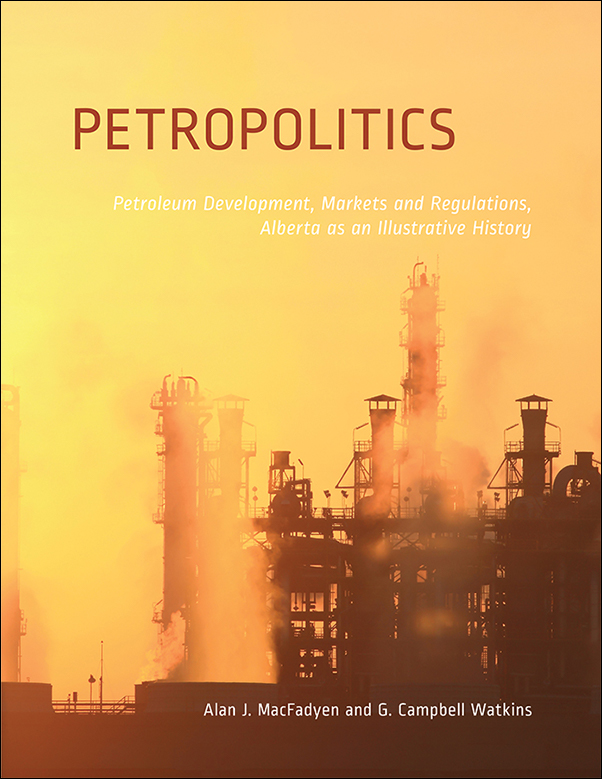
Petropolitics: Petroleum Development, Markets and Regulations, Alberta as an Illustrative History
Alan MacFadyen and G. Campbell Watkins
$44.95 CAD / $51.95 USD
512 pages, 108 illustrations
Paperback: 978-1-55238-540-1
Epub: 978-1-55238-754-2
Library PDF: 978-1-55238-541-8
March 2014
Petrolium History Society Book of the Year, Petropolitics is the only book to fully explore the complex and interrelated economic, political, and policy development of the Alberta oil and natural gas industry.
The importance of energy to the functioning of any economy has meant that energy industries are amongst the most regulated of industries. What might appear to be purely private decisions are made within a complex and evolving web of government regulations.
This book provides an economic history of the petroleum industry in Alberta as well as a detailed analysis of the operation of the markets for Alberta oil and natural gas, and the main governmental regulations (apart from environmental regulations) faced by the industry. The tools used within this study are applicable to oil and gas industries throughout the world.
Alan J. MacFadyen is Associate Professor Emeritus in the Department of Economics at the University of Calgary. In addition to initiating the energy economics program, he has authored numerous papers on energy and economics and has co-authored books on North American border issues and Alberta oil plays.
G. Campbell Watkins (1939-2005) was an adjunct professor of economics at the University of Calgary for twenty years. He went on to provide consulting services to a number of organizations worldwide and was recognized as an expert in energy policy and the application of economic analysis and statistical tools to the problems of the energy industry.
List of Tables
List of Figures and Maps
Acknowledgements
Units and Abbreviations
Part One: Overview
Petroleum and the Petroleum Industry: What Are They?
1.What is Petroleum?
2. What is the Petroleum Industry?
3: What are the Economic Aspects of the Petroleum Industry?
4: Conclusion
An Overview of the Alberta Petroleum Industry
1: Introduction
2: Before the Boom, 1946
3: Alberta’s Upstream Petroleum Industry
5: Conclusions
Alberta and World Petroleum Markets
1: Why World Markets Matter
2: Alberta’s Role in the World Oil Market
3: Determination of World Oil Prices: History
4: Major Determinants of World Oil Prices
5: Conclusion
Economic Analysis and Petroleum Production
1: Introduction
2: Supply and Demand
3: Market Equilibrium in Perfect Competition
4: Normative Aspects
5: Market Equilibrium in Imperfectly Competitive Markets
6: Applications to the Petroleum Industry
7: Conclusion
Part Two: Overview
Alberta’s Conventional Oil Resources
1: The Concept of Reserves
2: Historical Reserves Additions
3: Ultimate Reserves Potential
4: Summary and Conclusions
Crude Oil Output and Pricing
1: Introduction
2: Alberta Oil Production and Prices: The Data
3: Determination of Alberta Crude Oil Output and Prices
Non-Convectional Oil: Oil Sands and Heavy Oil
1: Introduction
2: Early History
3: Resources, Reserves, Production, and Costs
4: Government Policy in the Oil Sands
5: Conclusion
The Supply of Alberta Crude Oil
1: Introduction
2: Concepts of Crude Oil Supply
3: NEB Supply Studies
4: Direct Cost Estimation
5: Indirect Supply Estimation
6: Conclusions
Appendix: National Energy Board: Western Sedimentary Basin Oil Supply Forecasts
Part Three: Overview
Government Regulation: Trade and Price Controls
1: Introduction
2: Constitutional Responsibility over Petroleum
3: National Oil Policy (NOP): 1931-73
4: Strict Controls and the National Energy Program (NEP): 1973-85
5: Deregulation and the Free Trade Era: 1985-
6: Conclusion
Government Controls on the Petroleum Industry: Oil Prorationing
1: Introduction
2: Prorationing in Alberta
3. Optimum Well Spacing: The 1950 Proration Plan
4: Optimum Well Spacing: The 1957 Proration Plan
5: Efficiency of Production Under Prorationing in Alberta: Intensive Diseconomics
6: Summary and Conclusions
Appendix: A Reservoir Investment Model under Proration in Alberta
Economic Rent and Fiscal Regimes
1: Introduction
2: Conceptual Matters
3: Alberta Government Policy
4: Federal Regulations
5: Conclusion
Appendix: Alberta Crude Oil Royalty Regimes, 1951-2012
Part Four: Overview
The Alberta Natural Gas Industry: Pricing, Markets, and Government Regulation
1: Introduction
2: Natural Gas Production and Pricing
3: Alberta and Canadian Natural Gas Protection Policies
4: Price Controls and Other Market Regulations
5: Conclusions
The Petroleum Industry and the Alberta Economy
1: Introduction
2: Models of Economic Growth
3: The Petroleum Industry in the Alberta Economy
4: Conclusion
Lessons from the Alberta Experience
1: Introduction
2: Factors Related to Physical Aspects of Petroleum
3: Factors Related to Petroleum Markets
4: Factors Related to the Sharing of Economic Rent
5: Conclusions
Notes and References
Index
There is no other book which reviews the complete history of the Alberta petroleum industry and related economic and energy policy and institutional development.
—Gerry Angevine, Centre for Energy Studies, The Fraser Institute
WINNER, Petroleum History Society Book of the Year | 2014